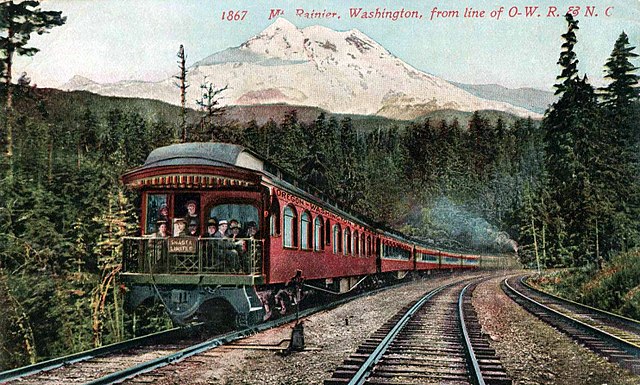Loading AI tools
Railway company From Wikipedia, the free encyclopedia
The Oregon Railroad and Navigation Company (OR&N) was a rail and steamboat transport company that operated a rail network of 1,143 miles (1,839 km) running east from Portland, Oregon, United States, to northeastern Oregon, northeastern Washington, and northern Idaho. It operated from 1896 as a consolidation of several smaller railroads.
 OR&N 197 at Oregon Rail Heritage Center | |
| Company type | Subsidiary of the Union Pacific Railroad |
|---|---|
| Industry | Railroad and Shipping |
| Founded | 1879 (Origins trace back to 1860) |
| Defunct | 1910 (O.R. & N) 1936 (O.W.R. & N) |
| Successor | Oregon-Washington Railroad and Navigation Company Union Pacific Railroad |
| Headquarters | United States |
Area served | United States |
Key people | Henry Villard |
| Parent | Union Pacific Railroad Company |

OR&N was initially operated as an independent carrier, but Union Pacific (UP) purchased a majority stake in the line in 1898.[1] It became a subsidiary of UP titled the Oregon–Washington Railroad and Navigation Company in 1910.[1][2] In 1936, Union Pacific formally absorbed the system, which became UP's gateway to the Pacific Northwest.
The OR&N was made up of several railroads:


The Oregon Railway and Navigation Company's purchase of the Oregon Steam Navigation Company in 1880 gave it a partial route on the south (Oregon) side of the Columbia River. The company then pursued expansion of its Columbia River route, surveying from where the Oregon Steam Navigation tracks ended at Celilo and continuing east to Wallula. By 1882 the route along the Columbia River was complete.
Starting in 1880, one of the competitors of the Oregon Railway and Navigation Company was the Shaver Transportation Company.
The company purchased right-of-way in 1882 from Alfred B. Meacham and John Harvey Meacham, along their Meacham Road through the Blue Mountains.[1] The Meacham road, built in 1862, had a lower pass (4,185 feet (1,276 m)) than competing roads, and was a corduroy road, allowing it to hold up in poor weather conditions.[1] The railroad was laid in 1884.[1]
Before 1879, the Oregon Steamship Company provided passenger service onboard coastal steamships from San Francisco, California, to Portland, Oregon, while the Oregon Steam Navigation Company operated multiple steamboats along the Columbia River. That year, the Oregon Railroad and Navigation Company purchased the entirety of both companies, which helped to create a monopoly over transportation in Oregon. The large steamships City of Chester, George W. Elder and Oregon were included in the purchase.[5]

In 1880, the Oregon Railroad and Navigation Company accepted delivery of the steamship Columbia from John Roach & Sons in Chester, Pennsylvania. Columbia was innovative for her time as she featured a dynamo that powered electric light bulbs, instead of oil-based lanterns. Columbia mainly served on the San Francisco, California, to Portland, Oregon, run in her career. Columbia remained with the company after the Union Pacific takeover in 1898. The shipping faction of the Oregon Railroad and Navigation Company that operated Columbia was renamed the San Francisco and Portland Steamship Company in 1904. Columbia was lost on July 20, 1907, following a collision with the schooner San Pedro.[6]

The George W. Elder was another steamship operated by the Oregon Railroad and Navigation Company. Originally an east coast steamer built by John Roach & Sons in Chester, Pennsylvania, the George W. Elder was purchased by the Oregon Steamship Company and sailed around Cape Horn to Oregon in 1876. The Oregon Steamship Company later sold the George W. Elder to the Oregon Railroad and Navigation Company.[7] On May 31, 1899, the George W. Elder left Seattle, Washington, carrying 126 passengers and crew on a 9,000-mile (14,000 km) scientific expedition to Russia, visiting Alaska and British Columbia along the way. Later that year, the George W. Elder was used as a troopship in the Philippines by the U.S. Army. The George W. Elder Continued to operate with the Oregon Railroad and Navigation Company until 1904, when it was transferred to the San Francisco and Portland Steamship Company. In 1905, the George W. Elder struck a rock in the Columbia River and sank into 16 feet (5 m) of water. The ship was subsequently raised and acquired by the North Pacific Steamship Company. In 1907, the George W. Elder helped rescue the survivors of the Columbia. The ultimate fate of the George W. Elder following its retirement in 1935 remains uncertain.[8]


The 1899 Annual Report of Directors for the Oregon Railroad & Navigation Company lists 26 or 27 other ships besides the Columbia and George W. Elder between June 30, 1898, and June 30, 1899. The fleet listing from June 30, 1898, to June 30, 1899, goes as follows[9]
Steamships
River Steamers
Tug boats
Barges

Seamless Wikipedia browsing. On steroids.
Every time you click a link to Wikipedia, Wiktionary or Wikiquote in your browser's search results, it will show the modern Wikiwand interface.
Wikiwand extension is a five stars, simple, with minimum permission required to keep your browsing private, safe and transparent.